
Austria-Hungary, also referred to as the Austro-Hungarian Empire, the Dual Monarchy or the Habsburg Monarchy, was a multi-national constitutional monarchy in Central Europe between 1867 and 1918. A military and diplomatic alliance, it consisted of two sovereign states with a single monarch who was titled both Emperor of Austria and King of Hungary. Austria-Hungary constituted the last phase in the constitutional evolution of the Habsburg monarchy: it was formed with the Austro-Hungarian Compromise of 1867 in the aftermath of the Austro-Prussian War and was dissolved shortly after Hungary terminated the union with Austria on 31 October 1918.

The Hungarian Revolution of 1956, also known as the Hungarian Uprising, was an attempted countrywide revolution against the government of the Hungarian People's Republic (1949–1989) and the policies caused by the government's subordination to the Soviet Union (USSR). The uprising lasted 12 days before being crushed by Soviet tanks and troops on 4 November 1956. Thousands were killed and wounded and nearly a quarter of a million Hungarians fled the country.

Viktor Mihály Orbán is a Hungarian lawyer and politician who has been Prime Minister of Hungary since 2010, previously holding the office from 1998 to 2002, and the leader of the Fidesz political party since 2003, and previously from 1993 to 2000. He was reelected as prime minister in 2014, 2018, and 2022. On 29 November 2020, he became the country's longest-serving prime minister.
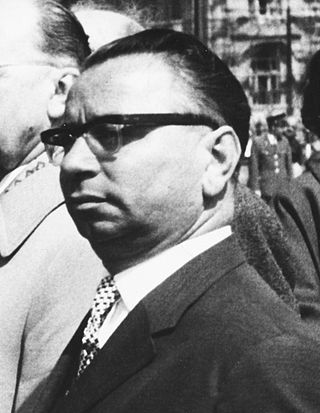
Gyula Kállai was a Hungarian communist politician who served as Minister of Foreign Affairs from 1949 to 1951, Chairman of the Council of Ministers from 1965 to 1967 and Speaker of the National Assembly from 1967 to 1971. He was also President of the National Council of the Patriotic People's Front from 1957 to 1989.
István is a Hungarian language equivalent of the name Stephen or Stefan. It may refer to:

The First Hungarian Republic, until 21 March 1919 the Hungarian People's Republic, was a short-lived unrecognized country, which quickly transformed into a small rump state due to the foreign and military policy of the doctrinaire pacifist Károlyi government. It existed from 16 November 1918 until 8 August 1919, apart from a 133-day interruption in the form of the Hungarian Soviet Republic. The republic was established in the wake of the dissolution of Austria-Hungary following World War I as a replacement for the Kingdom of Hungary. During the rule of Count Mihály Károlyi's pacifist cabinet, Hungary lost control over approximately 75% of its former pre-World War I territories, which was about 325,411 km2 (125,642 sq mi), without armed resistance and was subjected to unhindered foreign occupation. It was in turn succeeded by the Hungarian Soviet Republic but re-established following its demise, and ultimately replaced by the Hungarian Republic.
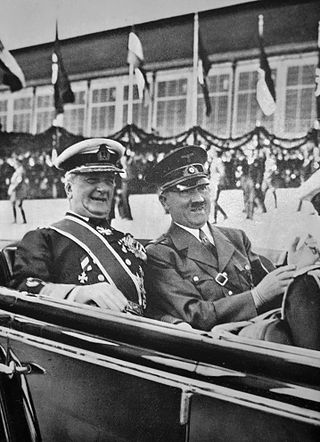
During World War II, the Kingdom of Hungary was a member of the Axis powers. In the 1930s, the Kingdom of Hungary relied on increased trade with Fascist Italy and Nazi Germany to pull itself out of the Great Depression. Hungarian politics and foreign policy had become more stridently nationalistic by 1938, and Hungary adopted an irredentist policy similar to Germany's, attempting to incorporate ethnic Hungarian areas in neighboring countries into Hungary. Hungary benefited territorially from its relationship with the Axis. Settlements were negotiated regarding territorial disputes with the Czechoslovak Republic, the Slovak Republic, and the Kingdom of Romania. On November 20, 1940, Hungary became the fourth member to join the Axis powers when it signed the Tripartite Pact. The following year, Hungarian forces participated in the invasion of Yugoslavia and the invasion of the Soviet Union. Their participation was noted by German observers for its particular cruelty, with occupied peoples subjected to arbitrary violence. Hungarian volunteers were sometimes referred to as engaging in "murder tourism."
Armenians in Hungary are ethnic Armenians living in Hungary.
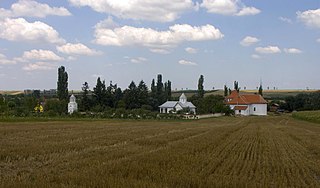
Gătaia is a town in Timiș County, Romania. It administers five villages: Butin, Percosova, Sculia, Șemlacu Mare, and Șemlacu Mic. Declared a town in 2004, it also administered four other villages until that time, when they were split off to form Birda commune.
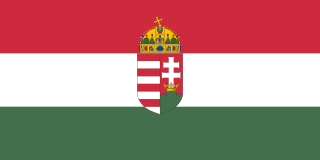
The Kingdom of Hungary, referred to retrospectively as the Regency and the Horthy era, existed as a country from 1920 to 1946 under the rule of Miklós Horthy, Regent of Hungary, who officially represented the Hungarian monarchy. In reality there was no king, and attempts by King Charles IV to return to the throne shortly before his death were prevented by Horthy.

The Second Hungarian Republic was a parliamentary republic briefly established after the disestablishment of the Kingdom of Hungary on 1 February 1946. It was itself dissolved on 20 August 1949 and succeeded by the Soviet-backed Hungarian People's Republic.

Initial relations between Hungary and Mexico date back to the short reign of the Emperor Maximilian I of Mexico from 1864 to 1867. Diplomatic relations with the Austro-Hungarian Empire were established in 1901, and diplomatic relations continued between an independent Hungary and Mexico after the dissolution of the Austro-Hungarian Empire in 1918, however, diplomatic relations were once again suspended between 1941 and 1974. Diplomatic relations were re-established between both nations on 14 May 1974 and have continued unabated since.
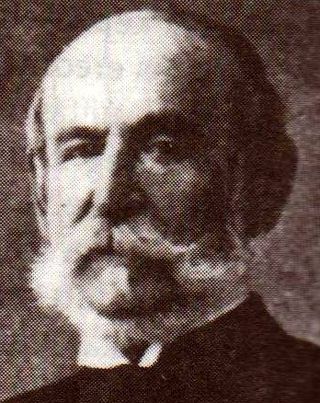
Baron Béla Orczy de Orczi was a Hungarian politician and freedom fighter, who served as Interior Minister between 1887 and 1889. He was also Minister of Home Defence for several months in 1884. He took part in the Hungarian Revolution of 1848, he fought against the rebelling Serbs in the area of Délvidék. He was the de facto Minister of Foreign Affairs between 1879 and 1890. His paternal grandfather was the poet Lőrinc Orczy.

The postal history of Hungary is strongly linked to the history of Hungary. While a messenger system was brought to the Carpathian Basin by Árpád as early as 895, modern mail delivery was first organized by the Habsburgs under the Austrian Empire.

The minister of foreign affairs of Hungary is a member of the Hungarian cabinet and the head of the Ministry of Foreign Affairs. The current foreign minister is Péter Szijjártó.
The minister of agriculture of Hungary is a member of the Hungarian cabinet and the head of the Ministry of Agriculture. The current agriculture minister is István Nagy.

Diplomatic relations between Azerbaijan and Hungary were established a year after the former state's declaration of independence from the Soviet Union.

Indo-Hungarian relations are the bilateral ties between India and Hungary. Indian embassy is located in Budapest and that of Hungary in New Delhi.
The Opposition Party was a political party that came to prominence during the 1848–49 revolution in Hungary. By contemporary political standards, they represented the far-left in the Hungarian parliament. Its leading political figure was Lajos Kossuth.

The Eger minaret is an Ottoman-era minaret tower located in Eger city, northern Hungary. It is one of the most northern minarets left from Ottoman rule in Europe. The minaret is 40 metres high and built from red sandstone. It was built in the early 17th century as part of the Djami of Kethuda mosque and used for the Muslim call to prayer (Adhan). The mosque no longer exists, but the minaret survives as a preserved monument of Hungary and a major tourist attraction of Eger. There are 98 steps on the spiral staircase inside, which leads to a balcony at 26 meters from the ground, offering unique views of the surrounding city.
















